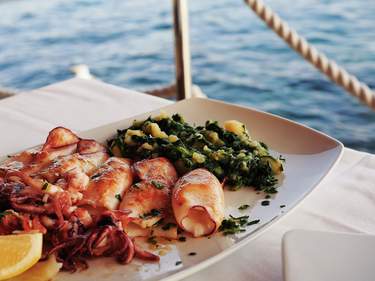If there is anywhere to rival Bled’s beauty it’s here. Cutting through the Savinja Alps near the Austrian border, Logarska Dolina is one of three impressive valleys. Driving into the valley is probably the most impressive part; having navigated the tight, winding mountain roads and followed a small bright-blue river for miles, we turned into Logarska and were dumbfounded by the view that opened up before us. An expanse of green grass, bordered by tall, pine-blanketed mountains, and an enormous grey cliff face baring down on us from the southern end – and no people in sight.
Once you’re over the view (if you can ever get over it), there’s a wealth of sports and activities to keep you occupied. After a lunch of trout, caught fresh from the Soca river, and locally-picked mushrooms at the Rinka visitor centre – just a ten minute drive north of Logarska – we hopped onto an electric bike to find the waterfall at the end of the valley. We cycled along the tarmac track, which in summer is usually littered with other cyclists, walkers and cars, completely alone except for two other walkers. It was peaceful, the sun was shining, the air was fragrant with pine and the ride was easy (thanks to the electric motor in my bike, of course – I dread to think how I’d have fared without it).
We left the bikes at the road to continue on foot, and fifteen minutes later we stood in the refreshing spray of a 90-metre-high waterfall – just what I needed. The ride back down to the rental hut was fast and cool, and while I’d been won over by the dizzying heights of the Savinja Alps towering over me, I had heard the view from above was unrivalled: it was time for some paragliding. Somewhere along the Panoramic Road, which snakes along the side of the valley, I strapped myself to a stranger and his parachute, and together we ran off the side of the mountains to glide over trees, a small scattering of farm houses and a lone church. I decided that paragliding was most definitely the best way to see Logarska Dolina.
Drink wine in the Drava Valley
The Drava Valley is the largest of Slovenia’s wine regions, producing mainly white grapes, and in pursuit of the region’s finest tipples we visited Jeruzalem, a small village in the Ljutomer-Ormož district. On the drive south from Ptuj, this renowned wine country rose out of the flat plains into undulous green hills, covered with newly-planted grapevines. We drove past small farmhouses teetering on the top of mounds, overlooking the elegant swirling lines of the vineyards beneath like a protective mother, and eventually we found our way to the Jeruzalem Ormož winery.




















